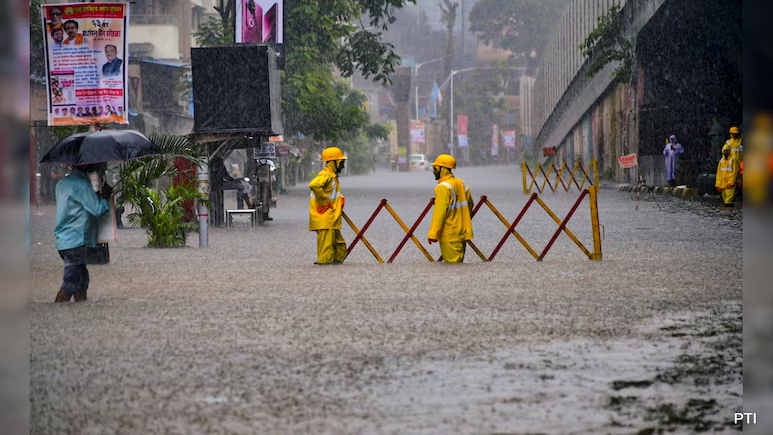Mumbai Rains, India’s financial capital, is grappling with severe monsoon woes as relentless heavy rainfall lashed the city and its suburbs on Monday, August 18, 2025. The Indian Meteorological Department (IMD) has issued a red alert for Mumbai, Thane, and Raigad districts until August 19, warning of extremely heavy precipitation that could exceed 200 mm in some areas. This comes after the city recorded over 100 mm of rain in just six hours, leading to widespread waterlogging, traffic chaos, and disruptions in daily life. As the downpour continues, residents are urged to stay indoors, with schools and colleges closed and local trains running behind schedule.
The IMD’s red alert indicates a high likelihood of flooding, landslides, and power outages, with an orange alert following for August 20 and a yellow alert for August 21. Between 8:30 AM and 5:30 PM, Vikhroli saw the highest rainfall at 135.5 mm, followed by Chembur at 140.80 mm, according to BMC data. South Mumbai areas like Colaba and Worli also reported significant downpours, exacerbating the situation in low-lying regions. High tide warnings, with waves up to 3.4 meters, have been issued, potentially worsening coastal flooding. For real-time weather updates, check our live weather tracker.
Widespread Impacts: Waterlogging and Traffic Paralysis
The heavy Mumbai rains has caused waterlogging in at least 14 key areas, including Andheri Subway, Hindmata, and King’s Circle, bringing traffic to a standstill. Major roads like the Western Express Highway and Eastern Freeway are inundated, with commuters facing hours-long delays. The BMC reported over 50 complaints of fallen trees and short circuits, further complicating mobility. Local trains, the city’s lifeline, are delayed by 30-45 minutes on the Central and Western lines, while flights at Chhatrapati Shivaji Maharaj International Airport (CSMIA) are experiencing average delays of 20 minutes due to low visibility. Mumbai Police have advised avoiding non-essential travel, deploying additional personnel at flood-prone spots.
Schools and colleges across Mumbai, Thane, and Navi Mumbai remain shut on August 19 as a precaution, with online classes recommended. The Maharashtra government has activated emergency response teams, including the NDRF, to handle potential evacuations in vulnerable areas like Dharavi and Kurla. Chief Minister Devendra Fadnavis has urged citizens to exercise caution, stating, “Stay safe and avoid waterlogged areas—our teams are on high alert.” This marks the third red alert this monsoon season, highlighting the intensifying weather patterns.
Mumbai Rains Weather Forecast and Climate Context
The IMD attributes the heavy Mumbai rains to a low-pressure area over the Arabian Sea, combined with the active southwest monsoon. Forecast models predict continued showers through August 20, with a gradual decrease by August 21. Mumbai’s average annual rainfall is around 2,300 mm, but this year’s July-August figures have already surpassed 1,500 mm, raising concerns about urban flooding. Climate experts link this to global warming, with rising sea levels exacerbating high-tide impacts. A 2024 IPCC report warns that Mumbai could face increased flood risks by 2050, with annual losses estimated at $1.5 billion if infrastructure isn’t upgraded. For more on climate change effects, read our monsoon impact analysis.
Historical data shows Mumbai rains vulnerability: The 2005 floods claimed over 1,000 lives, and the 2021 deluge caused 36 deaths. This year, the BMC has deployed 400 dewatering pumps and cleared over 10,000 tons of debris from drains, but critics argue it’s insufficient. The city’s drainage system, dating back to the British era, struggles with 300 mm+ daily rain, leading to perennial issues.
Government Response and Safety Measures
The BMC has activated its disaster management cell, with 24/7 control rooms and flood monitoring at 500 spots. Over 200 NDRF personnel are on standby, and the Indian Navy has offered support for rescue operations. Fadnavis has directed local authorities to relocate residents from slum areas if needed. Residents are advised to avoid water bodies and low-lying zones, with helplines (1916 for BMC, 100 for police) widely publicized.
Public transport adaptations include rerouted BEST buses and Metro services on high alert. The Western Railway has canceled several long-distance trains, while CSMIA urges passengers to check flight statuses. For travel advisories, visit our Mumbai traffic updates.
Economic and Social Toll
The rains have hit Mumbai’s economy, with markets like Crawford and Dadar submerged, causing losses estimated at ₹500 crore daily. Informal workers, including street vendors, are hardest hit, with many unable to work. Health concerns rise as waterborne diseases like dengue spike during monsoons—over 2,000 cases reported in Mumbai this July. Environmentalists call for sustainable urban planning, including mangrove restoration to mitigate flooding.
As Mumbai braces for more rain, the red alert serves as a stark reminder of the city’s monsoon vulnerabilities. Stay safe, and for ongoing coverage, follow our breaking news feed.

